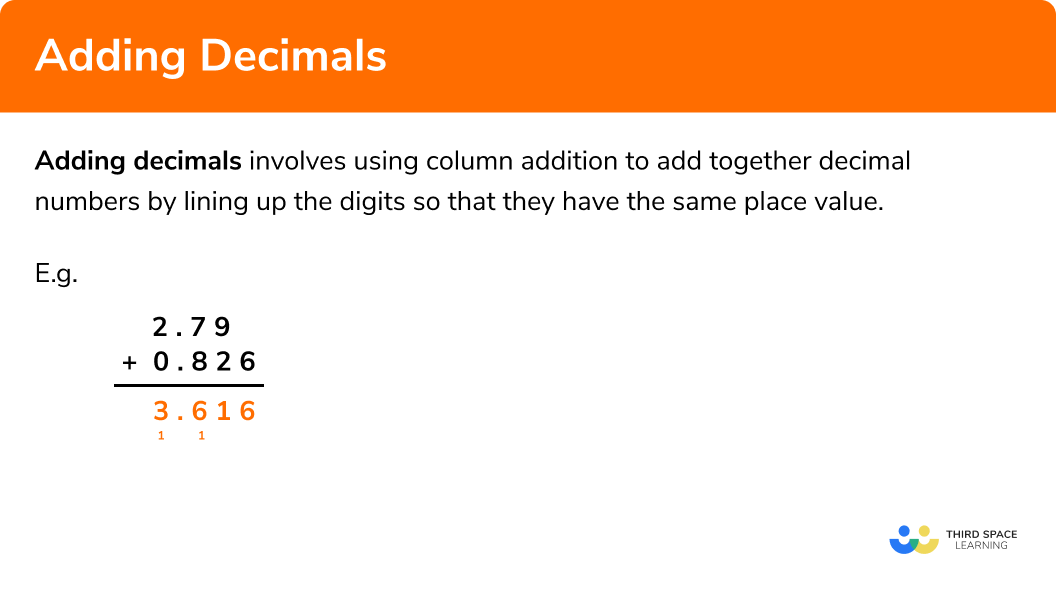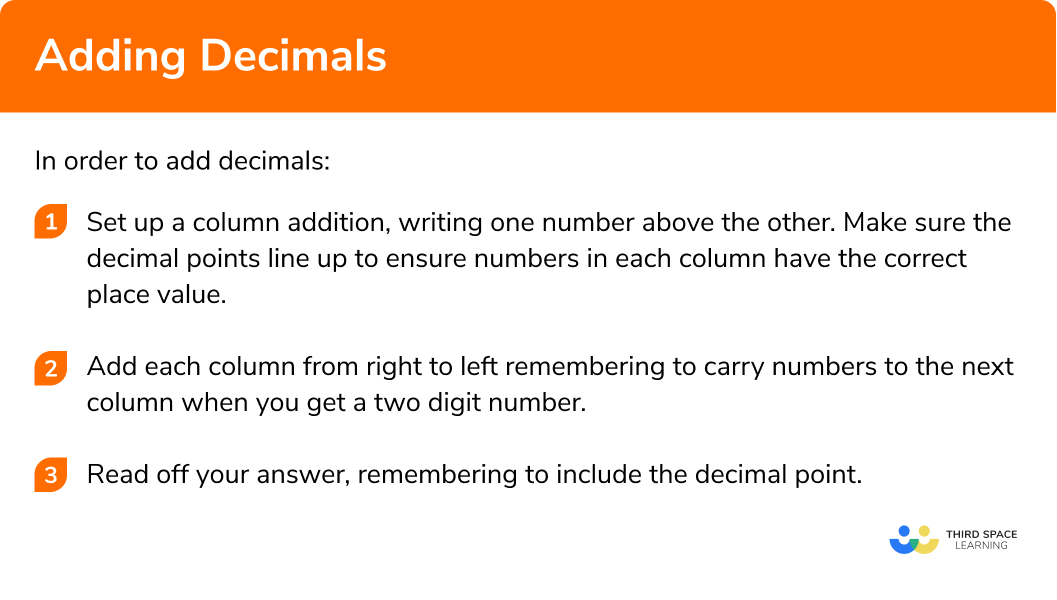One to one maths interventions built for KS4 success
Weekly online one to one GCSE maths revision lessons now available
This topic is relevant for:

Adding Decimals
Here we will learn about adding decimals including how to solve problems that involve decimal addition.
There are also adding decimals worksheets with word problems and problem solving questions based on Edexcel, AQA and OCR exam questions, along with further guidance on where to go next if you’re still stuck.
What is adding decimals?
Adding decimals involves using column addition to add together decimal numbers by lining up the digits so that they have the same place value.
The ones, decimal points, tenths, hundredths etc. should be lined up. This is particularly important to do if the values we are adding have been given to a different number of decimal places.
E.g.
A similar approach will be used for decimal subtraction.
What is adding decimals?

How to add decimals
In order to add decimals:
- Set up a column addition, writing one number above the other. Make sure the decimal points line up to ensure numbers in each column have the correct place value.
- Add each column from right to left remembering to carry numbers to the next column when you get a two digit number.
- Read off your answer, remembering to include the decimal point.
Explain how to add decimals in 3 steps


Adding decimals worksheet

Get your free adding decimals worksheet of 20+ questions and answers. Includes reasoning and applied questions.
DOWNLOAD FREE
Adding decimals worksheet

Get your free adding decimals worksheet of 20+ questions and answers. Includes reasoning and applied questions.
DOWNLOAD FREERelated lessons on decimals
Adding decimals is part of our series of lessons to support revision on decimals. You may find it helpful to start with the main decimals lesson for a summary of what to expect, or use the step by step guides below for further detail on individual topics. Other lessons in this series include:
Adding decimals examples
Example 1: adding numbers with one decimal place
Add together
- Set up a column addition, writing one number above the other. Make sure the decimal points line up to ensure numbers in each column have the correct place value.
2Add each column from right to left remembering to carry numbers to the next column when you get a two digit number.
3Read off your answer, remembering to include the decimal point.
The answer is
Example 2: adding numbers with two decimal places
Find the sum of
Set up a column addition, writing one number above the other. Make sure the decimal points line up to ensure numbers in each column have the correct place value.
Add each column from right to left remembering to carry numbers to the next column when you get a two digit number.
Read off your answer, remembering to include the decimal point.
The answer is
Example 3: adding numbers with three decimals places
Work out
Set up a column addition, writing one number above the other. Make sure the decimal points line up to ensure numbers in each column have the correct place value.
Add each column from right to left remembering to carry numbers to the next column when you get a two digit number.
Read off your answer, remembering to include the decimal point.
The answer is
Example 4: adding whole numbers and decimal numbers
Add together £
Set up a column addition, writing one number above the other. Make sure the decimal points line up to ensure numbers in each column have the correct place value.
Fill in missing zeros if it helps.
Add each column from right to left remembering to carry numbers to the next column when you get a two digit number.
Read off your answer, remembering to include the decimal point.
The answer is £
Example 5: adding numbers with different amounts of decimal places
Find the sum of
Set up a column addition, writing one number above the other. Make sure the decimal points line up to ensure numbers in each column have the correct place value.
Fill in missing zeros if it helps.
Add each column from right to left remembering to carry numbers to the next column when you get a two digit number.
Read off your answer, remembering to include the decimal point.
The answer is
Example 6: adding more than two decimal numbers
Work out
Set up a column addition, writing one number above the other. Make sure the decimal points line up to ensure numbers in each column have the correct place value.
Add each column from right to left remembering to carry numbers to the next column when you get a two digit number.
Fill in missing zeros if it helps.
Read off your answer, remembering to include the decimal point.
The answer is
Common misconceptions
- Not lining up the decimal point
A common error when adding decimals occurs when the decimal points are not lined up but instead the last digits are lined up.
E.g.
Practice adding decimals questions
1. Add together 3.7 and 5.6
9.3

8.13

8.3

9.13

You must remember to line up the decimal points carefully and carry to the next column if the sum of the digits gives a two digit answer.
2. Work out £12.84 + £6.19
£18.103

£19.03

£18.913

£19.3

You must remember to line up the decimal points carefully and carry to the next column if the sum of the digits gives a two digit answer.
3. Find the sum of 0.069 and 5.987
5.1056

6.677

6.56

6.056

You must remember to line up the decimal points carefully and carry to the next column if the sum of the digits gives a two digit answer.
4. Add together 2 and 3.87
5.87

3.89

4.07

23.87

You must remember to line up the decimal points carefully, you can fill in missing zeros if it helps.
5. Find the sum of 9.04 and 17.381
26.421

18.285

107.781

26.385

You must remember to line up the decimal points carefully and carry to the next column if the sum of the digits gives a two digit answer. You can fill in missing zeros if it helps.
6. Work out 20.3 + 13.67 + 0.998
2568

4.395

34.968

34.068

You must remember to line up the decimal points carefully and carry to the next column if the sum of the digits gives a two digit answer. You can fill in missing zeros if it helps.
Adding decimals GCSE questions
1.
(a) Work out £ 13.67 + £ 8.59
(b) Work out 55.6 + 2.392 + 12.48
(3 marks)
a)
Correct answer of £ 22.26
(1)
b)
57.992 or 68.08 or 14.872 seen
(1)
Correct answer of 70.472
(1)
2. Complete the following calculations
(a)
(b)
(5 marks)
a)
2 in first box
(1)
7 in second box
(1)
b)
8 in top box
(1)
1 in first box in second row
(1)
6 in second box in second row
(1)
3. Find the perimeter of the irregular pentagon.
(2 marks)
(1)
Correct answer of 18.9
(1)
Learning checklist
You have now learned how to:
- Understand and use place value for decimals, measures and integers of any size
- Use the four operations, including formal written methods, applied to integers, decimals, proper and improper fractions, and mixed numbers, all both positive and negative
The next lessons are
Still stuck?
Prepare your KS4 students for maths GCSEs success with Third Space Learning. Weekly online one to one GCSE maths revision lessons delivered by expert maths tutors.

Find out more about our GCSE maths tuition programme.